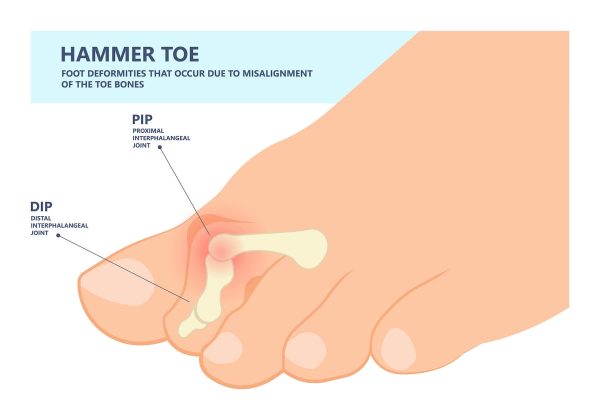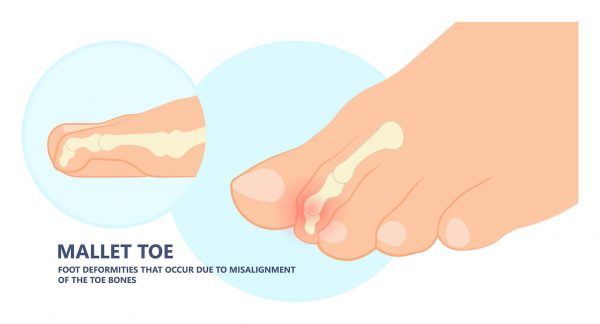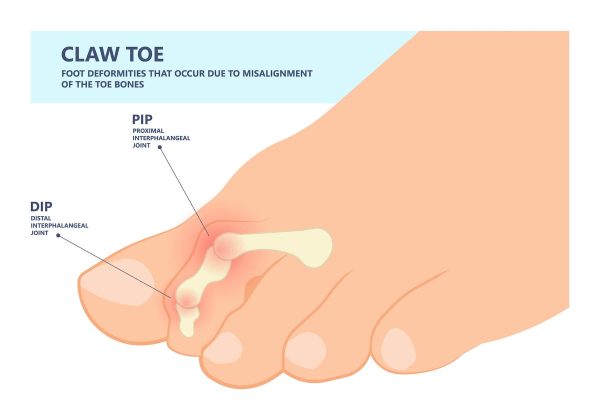Your trusty toes are there to help you move confidently and maintain balance at all times. However, when exposed to repeated stress, these small bones can be pulled into a bent position. If one or more of your toes are not straight, you may have a toe deformity. Never fear! We’ll dive into the cause, type, and treatment options for these toe woes so you can put your best foot forward.
What Causes a Toe Deformity?
When muscles, tendons, and other tissues are overpowered by another muscle within your toe, the imbalance can cause your toe to become misaligned, developing into a toe deformity over time. This can occur when the muscles in your toes lose their strength, such as with pandemic foot.
Additionally, if a toe is regularly forced into a bent position— as with tight-fitting shoes— the toe will stay in that position even when the cause is removed.
Deformities in the toes can also be caused by:
- Genetics.
- Conditions like high arches or flat feet.
- Injury to your toes or foot.
- Nerve damage from diabetes.
Types of Toe Deformities
The type of toe deformity depends on the specific location of the bend in your toe bones (phalanges). Each deformity can be considered either flexible or rigid. A flexible bend means that the joint is still able to move but naturally goes back to the incorrect position.
A rigid deformity indicates that the joint is immobile and “stuck” in a bent position because the muscles and tendons are too tight for movement. Most crooked toes are usually flexible at first but harden into place over time. If you have toes that are “stuck” in a bent position, it’s important to seek the care of a podiatrist as soon as possible.
Hammertoe
If the toe is bent abnormally at the middle joint, it may be the most common type of toe deformity: hammertoe. In this case, the toe curls downward, resembling a hammer. Hammertoe is often seen in the middle toes but can affect other toes as well.

Mallet Toe
Hammertoe and mallet toe are very similar. The main difference is that a mallet toe is when the upward bend occurs in the last toe joint, closest to the toenail. Mallet toe most commonly occurs in the second toe.

Claw Toe
The toe deformity is considered claw toe when there is a downward bend at the middle joint and an upward bend at the end joint. These misalignments cause the toe to resemble a “claw.” Claw toe commonly affects all four smaller toes at the same time.

Additional Symptoms of Toe Deformities
Aside from the bent appearance of the toe, toe deformities can cause:
- Pain and inflammation.
- Improper fitting shoes and discomfort.
- Corns and calluses from bent toes rubbing against each other or your shoe.
Since these symptoms are usually very uncomfortable, it’s important to address the root cause with suitable treatment options.
Treatment Options for Toe Deformities
When treated early, most people find relief with nonsurgical treatments such as wearing proper-fitting shoes, medication, toe splints, or strengthening and stretching toe muscles through exercises. However, more progressed toe deformities may require surgery. Without treatment, the bend can worsen and may become a permanent deformity.
Get Your Toes Dancing Again
If you suffer from hammertoe, mallet toe, or claw toe, schedule an appointment with your podiatrist. While general practitioners have knowledge of common ailments, a foot and ankle doctor will have the expertise needed to help your toes straighten up.
Foot & Ankle Group has several locations in Southwest Florida ready to discuss your treatment options for toe deformities and all other conditions and injuries below the knee. We are here to help.
Categorized in: Blog
Comments are closed